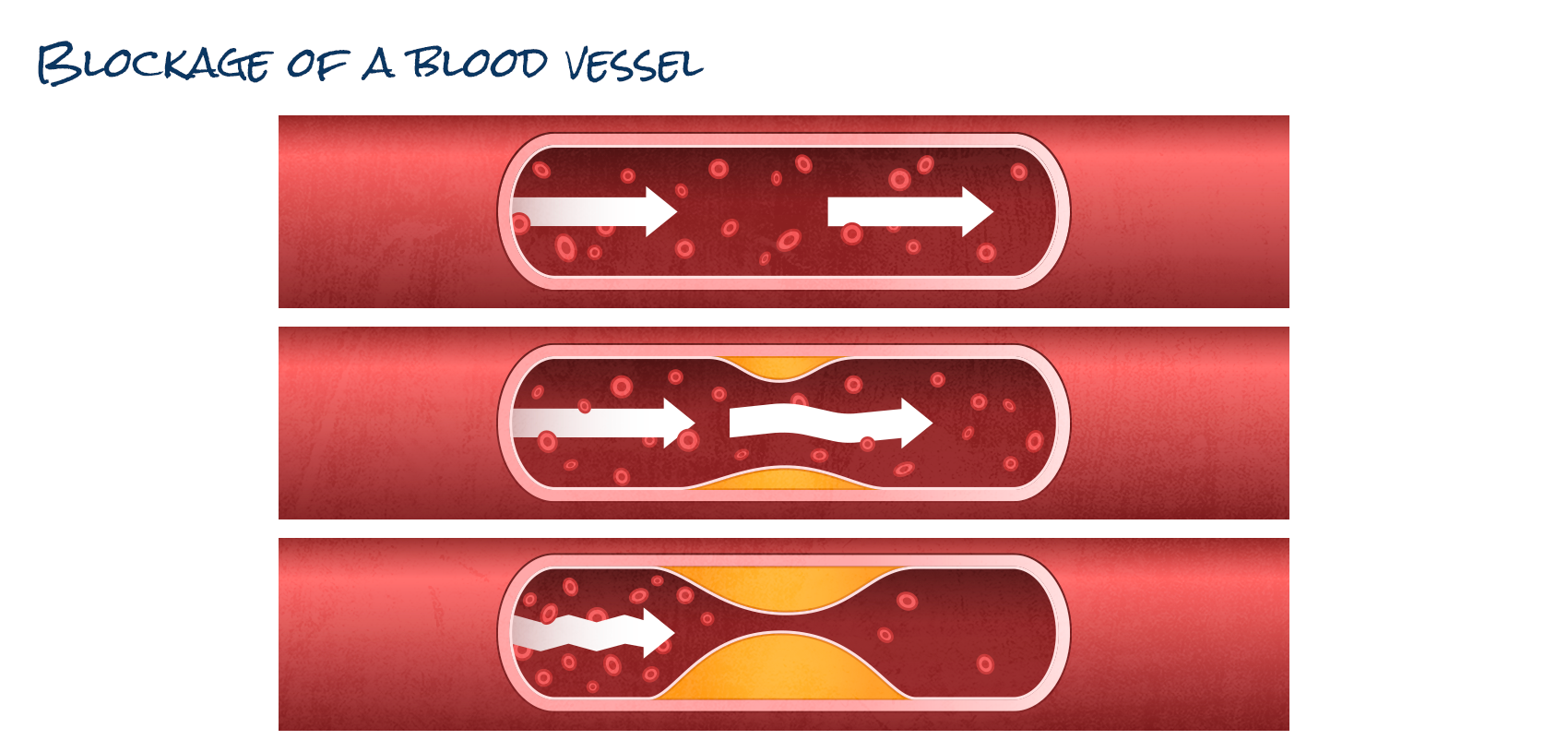Coronary Artery Disease
(CAD)
Causes
The intrusion of cholesterol and fat into the artery walls can begin very early in life and often builds up as we age. However, certain risk factors increase the likelihood that fatty streaks in the artery wall will develop into atherosclerosis and coronary artery disease (CAD). Some of these heart disease risk factors are simply part of who we are and can’t be changed. But many risk factors can be improved by following the treatment prescribed by your doctor and by making healthy lifestyle choices. That means you have the power to reduce your risk of developing heart disease.

Stages of development of blockage in heart arteries (coronary plaque). The first artery is a healthy normal artery. As atherosclerosis develops, the artery gradually narrows, as shown from top to bottom in this diagram. Over time, extensive plaque can build up, allowing blood to pass through the blood vessels. Finally, the blockage becomes so severe that it restricts blood from passing through, as shown in the final illustration.
Uncontrollable risk factors
- Age – The risk of CAD increases as you age. The risk starts to climb for men* at about age 45 when 10 out of every 1,000 men develop signs of CAD. By age 55, the risk has doubled to about 21 out of every 1,000 men. It continues to rise until, by age 85, about 74 out of every 1,000 men have CAD. For women*, the risk of CAD also climbs with age, but the trend begins about 10 years later than in men, especially with the onset of menopause.
- Gender – Men are more likely to develop heart disease than women, but that difference begins to disappear after women go through menopause. Women also have several sex-specific risk factors that increase their risk of developing CAD.
- Family history of heart disease – Your risk of heart disease is approximately doubled if a parent or sibling developed heart disease early in life (before age 55 for men and age 65 for women).
- Medical conditions – Several medical conditions, such as autoimmune diseases, inflammatory disorders, HIV/AIDS, and chronic kidney disease, increase the risk of CAD.
Controllable risk factors
- Smoking and using other tobacco products – When you smoke, you expose your heart and blood vessels to nicotine, carbon monoxide, and other harmful substances contained in smoke. This causes blood vessels to constrict, blood pressure to increase, and cholesterol levels to climb. In addition, smoking deprives the body’s tissues of oxygen, damages the inner lining of blood vessels, allows plaques to grow inside your arteries, and makes it more likely that dangerous blood clots will form.
- High cholesterol levels – High LDL cholesterol — the so-called “bad” cholesterol — can increase plaque buildup in the heart's arteries. It’s also unhealthy to have low levels of HDL, or “good” cholesterol. Your ideal blood cholesterol level depends on your age, gender, and history of CAD. Still, for most people with CAD, the target LDL cholesterol level is 100 mg/dL or below, and the target HDL cholesterol level is above 40 mg/dL for men and above 50 mg/dL for women.
- High blood pressure – If your blood pressure is above 140/90 mmHg for long periods, it can damage the blood vessels. This not only makes cholesterol plaque more likely to form, but it also causes the artery walls to become thicker, stiffer, and less able to expand and contract with changes in activity and other physical demands.
- Diabetes – High blood sugar levels can damage the blood vessels throughout the body, making atherosclerotic plaque more likely to develop. Learning more about diabetes prevention and treatment is a wise investment in cardiovascular health.
- Being overweight or obese – Carrying around too much weight strains your heart and makes it more difficult to control high blood pressure, high cholesterol levels, and diabetes. Men and women who are overweight are about 20% more likely to develop CAD, and being obese—more than 20% above ideal body weight—increases the risk of CAD by 46% in men and 64% in women.1
- Physical inactivity – A lack of exercise weakens your muscles and makes it harder to control several other CAD risk factors, including blood pressure, cholesterol levels, diabetes, obesity, and stress.
- Metabolic syndrome – This term describes a cluster of traits that increase the risk of developing CAD together. These traits include high blood sugar; high blood pressure; low levels of “good” HDL cholesterol; high blood levels of fats known as triglycerides; and excess body weight, particularly in the belly area.
- Stress – High levels of stress in your life, or a tendency to often feel angry, have also been linked to an increased risk for CAD. Learning how to manage stress can be good for your heart.
- High levels of C-reactive protein (CRP) – CRP is produced by the body in response to infection or inflammation. Your doctor may use a special high-sensitivity CRP test to look for signs that you have inflammation in the arteries of your heart. If your CRP levels are high, your risk of heart attack increases.
*The term “men” in the context of “cardiovascular health” applies to individuals assigned male at birth (AMAB) who have a male biological reproductive system, which includes a penis, scrotum, testes, epididymis, vas deferens, prostate, and seminal vesicles.
*The term “women” in the context of “women’s cardiovascular health” applies to individuals assigned female at birth (AFAB) who have a female biological reproductive system, which includes a vagina, uterus, ovaries, Fallopian tubes, accessory glands, and external genital organs.